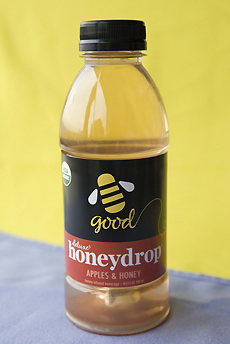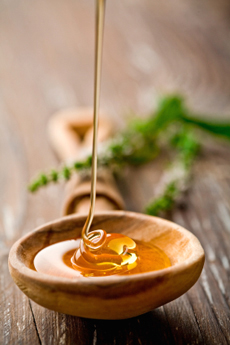
 The Apples & Honey flavor of Honeydrop tastes like apple juice and honey. As the bee says, it tastes good! Photography by Corey Lugg | THE NIBBLE. The Apples & Honey flavor of Honeydrop tastes like apple juice and honey. As the bee says, it tastes good! Photography by Corey Lugg | THE NIBBLE.
|
KAREN HOCHMAN is Editorial Director of THE NIBBLE.
|
|
April 2009
|
 |
Honeydrop Honey Drink
Organic, Low Glycemic, Kosher Soft Drink Alternative
CAPSULE REPORT: Love honey? Want a natural, sweet drink without sugar? The makers of Honeydrop invite you to “bee alive” with their line of noncarbonated, honey-infused beverages as an alternative to the juice drinks and sweet flavored waters on the market. USDA-certified organic and OU-certified kosher, in BPA-free bottles, this is a drink one can feel good about. This is Page 1 of a three-page article. Click on the black links below to visit other pages.
Overview
Honeydrop is a lightly-flavored line of honey drinks, water blended with honey and juice or tea. David Luks, who converted to the organic lifestyle for health reasons, conceived of Honeydrop (the brand uses a small “h,” honeydrop) as an alternative to sodas, juice drinks and flavored waters that use refined sugar, and juices that may have no added sugar, but are very high in natural sugars and carbohydrates. Honeydrop has 80 calories per 16-ounce bottle, no added sugar, is certified organic, OU-kosher and in BPA-free recyclable bottles.
The Health Benefits Of Honey
Honey has long been made into a pleasure drink. Mead, or honey wine, the “drink of the gods,”* is a fermentation of honey and water; a variant, rhodomel, added rose hips or rose petals. It was drunk for health reasons, too, as we’ll see in a moment.
*While mead was drunk on Mount Olympus, it, and similar honey-based drinks, were also drunk by many early cultures. The ancient Norse used mead to drink toasts to their gods and as a ceremonial accompaniment. The beverage also plays a role in the medieval epic poem “Beowulf,” written around 700 C.E.
While modern claims count honey as a panacea for allergies, ulcers, even cancer, these are more anecdotal than established science. It is a fact that honey excels in wound care, with antibiotic and antimicrobial properties that protect burns and other wounds. It also has antiseptic properties that help with sore throats and coughs—hence all those honey lozenges.
|

Photo of honey by Liv Friis-Larsen | IST. |
Yet honey has been used since ancient times for its medicinal effects. Hydromel, the Roman word for mead, was a popular beverage as well as a medicine for digestive ailments. Oxymel, a beverage made of honey, vinegar, sea salt and rainwater, was the cure for sciatica, gout and rheumatic ailments (a modern version is used as an expectorant). Oenomel, made from unfermented grape juice (verjus) and honey, was used for gout and nerves.†
†Source: Honey-Health.com.
Continue To Page 2: Honey Nutrition

|




 The Apples & Honey flavor of Honeydrop tastes like apple juice and honey. As the bee says, it tastes good! Photography by
The Apples & Honey flavor of Honeydrop tastes like apple juice and honey. As the bee says, it tastes good! Photography by 